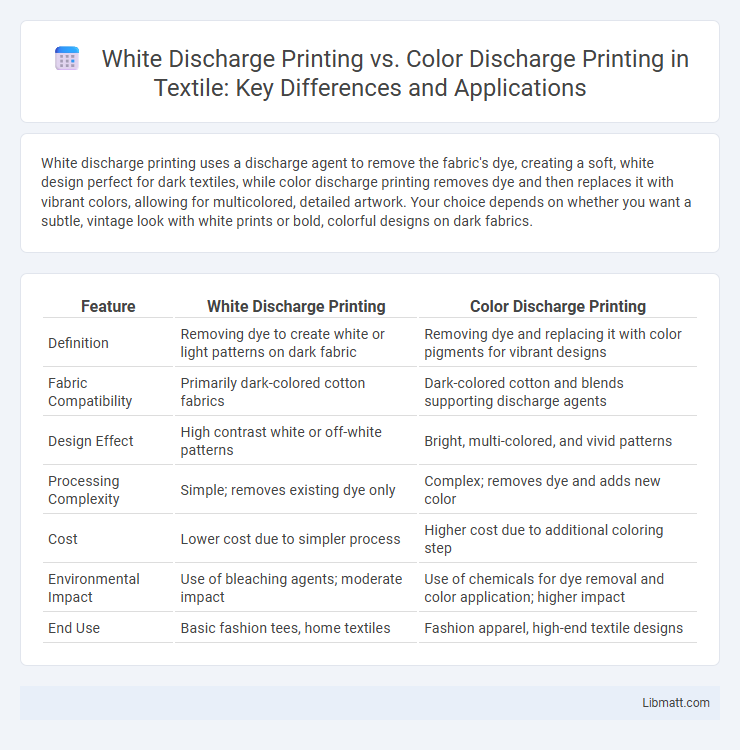White discharge printing uses a discharge agent to remove the fabric's dye, creating a soft, white design perfect for dark textiles, while color discharge printing removes dye and then replaces it with vibrant colors, allowing for multicolored, detailed artwork. Your choice depends on whether you want a subtle, vintage look with white prints or bold, colorful designs on dark fabrics.
Table of Comparison
| Feature | White Discharge Printing | Color Discharge Printing |
|---|---|---|
| Definition | Removing dye to create white or light patterns on dark fabric | Removing dye and replacing it with color pigments for vibrant designs |
| Fabric Compatibility | Primarily dark-colored cotton fabrics | Dark-colored cotton and blends supporting discharge agents |
| Design Effect | High contrast white or off-white patterns | Bright, multi-colored, and vivid patterns |
| Processing Complexity | Simple; removes existing dye only | Complex; removes dye and adds new color |
| Cost | Lower cost due to simpler process | Higher cost due to additional coloring step |
| Environmental Impact | Use of bleaching agents; moderate impact | Use of chemicals for dye removal and color application; higher impact |
| End Use | Basic fashion tees, home textiles | Fashion apparel, high-end textile designs |
Understanding Discharge Printing Techniques
Discharge printing removes the dye from fabric to create designs, with white discharge printing using a bleaching agent to produce bright white patterns on dark garments, ideal for bold, high-contrast visuals. Color discharge printing adds pigments during the discharge process, enabling vibrant, multicolor designs with a soft hand feel, suitable for complex artwork on dark fabrics. Both techniques require precise chemical handling to achieve desired effects while maintaining fabric integrity and durability.
What Is White Discharge Printing?
White discharge printing involves using a special paste that removes the dye from dark fabrics, replacing it with a white or lighter color, creating a soft, vintage look. This technique allows the white discharge ink to bond directly with the fabric, resulting in a breathable and smooth finish without adding any heavy layer on top. It is ideal for dark-colored garments where a crisp, bright white design is desired without the stiffness of traditional screen printing.
What Is Color Discharge Printing?
Color discharge printing is a textile technique where a discharge agent removes the original dye from a fabric and simultaneously replaces it with a different color, creating vibrant, multi-colored designs on dark garments. Unlike white discharge printing, which only bleaches out the original color to leave a white or natural base, color discharge adds a precise new pigment during the discharge process for more complex and colorful patterns. This method allows for soft, breathable prints with excellent colorfastness and intricate detailing on materials like cotton and blends.
Key Differences Between White and Color Discharge Printing
White discharge printing uses a discharge agent to remove the base fabric color, leaving a white or light design, ideal for dark garments and simple artwork. Color discharge printing combines discharge with pigment dyes, enabling vibrant, multicolor designs with a soft hand feel and increased durability. The key differences lie in color retention, complexity of design, and the overall visual impact on dark textiles.
Fabric Compatibility for Each Method
White discharge printing is most effective on dark cotton fabrics, where the discharge agent removes dye to create a bright, white design by bleaching the fabric fibers. Color discharge printing requires fabrics dyed with dischargeable pigments or reactive dyes, typically natural fibers like cotton or blends, allowing selective removal of the base color to reveal a pre-printed color or a lighter shade beneath. Both methods work best on natural fibers due to their absorbency and reaction to the discharge agents, with synthetic fabrics generally offering poor results.
Advantages of White Discharge Printing
White discharge printing offers exceptional opacity and brightness, making it ideal for vibrant designs on dark fabrics. It provides a soft hand feel since the discharge agent removes the fabric dye instead of adding heavy ink layers. Your garments benefit from better breathability and durability compared to color discharge printing, which often requires additional ink layers that can stiffen the material.
Benefits of Color Discharge Printing
Color discharge printing offers vivid, durable prints with a soft, breathable feel by removing the fabric's dye and replacing it with colored pigments. This technique enables intricate multicolor designs on dark fabrics without compromising softness or causing excessive ink build-up. The vibrant, long-lasting results make color discharge printing ideal for high-quality apparel and detailed artistic graphics.
Applications and Use Cases
White discharge printing is primarily used for dark-colored fabrics where achieving bright, opaque white designs is essential, such as in custom apparel, sportswear, and promotional clothing. Color discharge printing excels in producing vibrant, soft-feeling prints on dark garments by replacing the fabric's dye with pigment, making it ideal for intricate multicolor designs, fashion apparel, and high-end textile products. Both techniques offer excellent washability and breathability, with white discharge preferred for bold, simple graphics and color discharge favored for detailed, colorful artwork.
Common Challenges and Solutions
White discharge printing often faces challenges with maintaining opacity on dark fabrics, requiring high-quality discharge agents to ensure vibrant and consistent prints. Color discharge printing struggles with color accuracy and vibrancy due to dye removal and replacement processes, which can be mitigated by precise temperature control and optimized ink formulations. Both techniques benefit from thorough fabric pre-treatment and advanced curing methods to enhance print durability and minimize defects like bleeding or fading.
Which Discharge Printing Method Is Right for Your Project?
White discharge printing offers crisp, vibrant results on dark fabrics by removing dye and replacing it with white ink, ideal for high-contrast, minimalistic designs. Color discharge printing removes the garment's dye while infusing colored discharge inks, allowing for soft, vintage-style prints with a broader color palette. Choosing between them depends on your project's desired visual impact, fabric color, and complexity of colors needed.
White discharge printing vs Color discharge printing Infographic

 libmatt.com
libmatt.com